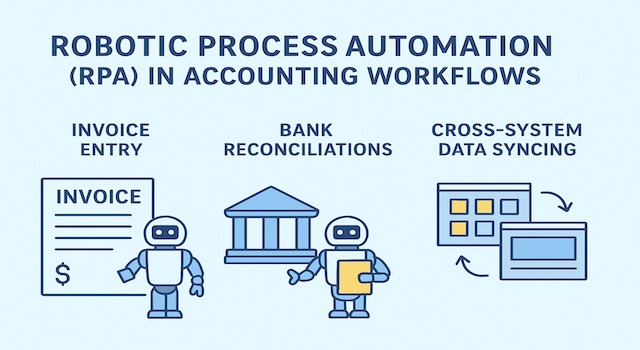Accounting
Robotic Process Automation (RPA) in Accounting Workflows

Robotic Process Automation (RPA) has become a cornerstone of digital transformation in finance. By mimicking the actions of human users across accounting software, ERPs, and bank portals, RPA tools can automate repetitive, rules-based tasks like invoice entry, reconciliations, and cross-system data syncing. The result: fewer manual errors, faster closes, and finance teams freed up for higher-value work.
What Is RPA in Accounting?
RPA uses “software robots” that interact with applications the same way humans do—clicking, typing, copying, and pasting—without needing to change the underlying systems. Unlike traditional integrations, RPA can bridge gaps between legacy platforms, spreadsheets, and modern cloud tools, making it especially powerful for accounting workflows where multiple systems must align.
Automating Invoice Entry
Manual invoice entry is error-prone and time-consuming. RPA automates the process by:
- Extracting data: Pulling vendor, date, amount, and line-item details from PDF invoices, scanned documents, or email attachments.
- Validating against policies: Checking vendor names, PO numbers, and tax codes before posting entries.
- Posting automatically: Entering validated invoices into the accounting system or ERP with audit logs attached.
The result is faster AP processing, reduced data entry errors, and improved vendor satisfaction due to fewer delays.
Streamlining Bank Reconciliations
RPA can handle the repetitive matching work in reconciliations by:
- Logging into bank portals to download statements automatically.
- Comparing transactions against the GL or sub-ledgers.
- Flagging exceptions—like timing differences or unmatched items—for human review.
This accelerates the month-end close, reduces manual spreadsheet work, and ensures finance teams can focus on investigating true discrepancies instead of routine matches.
Cross-System Data Syncing
Many organizations struggle with fragmented data spread across ERPs, CRMs, payroll platforms, and expense management tools. RPA bots can:
- Transfer data between systems that don’t natively integrate.
- Keep master data (like customer and vendor records) consistent across platforms.
- Automate journal entries triggered by events in external systems, such as payroll or sales transactions.
By ensuring consistency across systems, RPA helps maintain data integrity and reduces reconciliation workload downstream.
Benefits for Finance Teams
- Efficiency gains: Automating routine tasks can cut processing time by 50–70%.
- Error reduction: Bots follow defined rules consistently, minimizing manual entry mistakes.
- Scalability: RPA can handle spikes in volume (e.g., year-end, seasonal invoicing) without requiring extra headcount.
- Auditability: Every bot action can be logged for compliance and traceability.
Limitations and Risks
- Rule-based scope: RPA is best for structured, repetitive tasks. Complex judgment calls still require humans.
- Bot maintenance: Changes to application interfaces (like updated bank portals) can break bots and require updates.
- Scalability limits: While RPA is powerful, integrating APIs or AI models may be more efficient for long-term scaling.
Leading Vendors in Accounting RPA
- UiPath, Automation Anywhere, Blue Prism: Enterprise-grade platforms with prebuilt finance bots.
- Accounting-focused RPA providers: Niche vendors offering bots specifically for AP/AR automation.
- ERP-native automation: Some ERPs (e.g., NetSuite, SAP) embed RPA-like automation features directly in workflows.
Best Practices for Implementation
- Identify high-volume pain points: Start with invoice entry or reconciliations where ROI is clear.
- Document processes: Map current workflows thoroughly before programming bots.
- Pilot before scaling: Deploy RPA in a limited process to test stability and user adoption.
- Set monitoring protocols: Continuously track bot performance and update as systems evolve.
- Combine with AI: Enhance RPA with AI for unstructured tasks like reading invoices or anomaly detection.
ROI Snapshot
Organizations adopting RPA in accounting report a 30–60% reduction in processing time, fewer manual errors, and improved staff capacity for strategic work like financial planning and analysis. Savings often cover implementation costs within 12–18 months.
Bottom Line
RPA is proving to be a practical and high-ROI automation tool for accounting departments. By handling invoice entry, bank reconciliations, and cross-system data syncing, RPA reduces friction in daily workflows and gives finance teams the bandwidth to focus on analysis, compliance, and decision support. As more vendors embed RPA directly into finance platforms, its adoption will continue to expand across businesses of all sizes.






